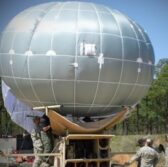 The U.S. Army plans to launch a Raytheon-built cruise missile detector at the Aberdeen Proving Ground next week to test the system’s integration capabilities with NORAD command and control nodes.
The U.S. Army plans to launch a Raytheon-built cruise missile detector at the Aberdeen Proving Ground next week to test the system’s integration capabilities with NORAD command and control nodes.
The radar system, a component of the Army’s Joint Land Attack Cruise Missile Defense Elevated Netted Sensor program, is housed in a tethered airship that will be suspended in midair at an altitude of 10,000 feet for three years, the Army News Service said Wednesday.
From its perch, the blimp-like vehicle, the first of two JLENS aerostats that will participate in the operational exercise, is designed to look over the horizon and perceive suspected air threats within an area range from upstate New York to Norfolk, Virginia.
It could stay afloat for up to 30 days straight, offering savings that Maj. Gen. Glenn Bramhall, commander, 263rd Army Air and Missile Defense Command, told reporters could pose as an alternative to manned, airborne surveillance missions.
“If I can detect this thing much further out, it gives commanders [more] time to get air assets into place and to alert people on the ground of the threat,” he added.
“If I can give a command four more minutes or five more minutes, that’s a lot of time.”




